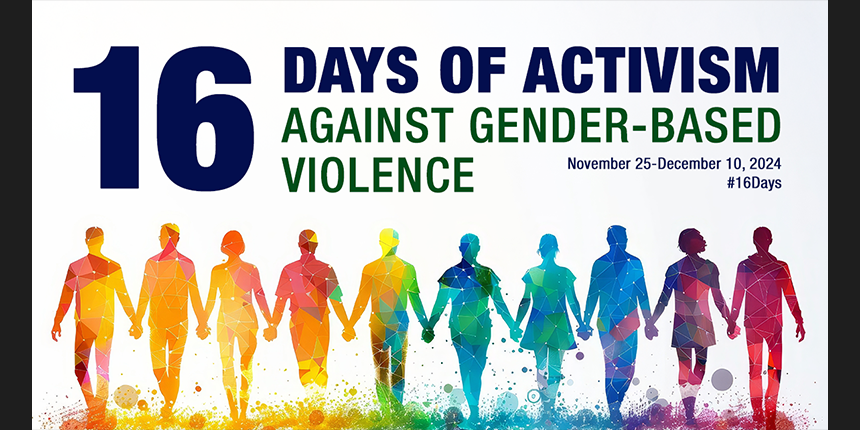

**Trigger Warning: This post includes mentions of gender-based violence, and femicide. A list of regionally available support can be found here for those who may need it.
Across the world, the period from November 25 to December 10 marks the 16 Days of Activism Against Gender-Based Violence. The 16 Days are an international campaign that calls for prevention and an end to gender-based violence (GBV).
In Canada, the 16 Days include December 6, the National Day of Remembrance and Action on Violence Against Women, designated by Parliament in the aftermath of December 6, 1989, when 14 women—almost all of whom were engineering students—were murdered at École Polytechnique in Montreal, QC. December 6, 2024, marks the 35th anniversary of this act of femicide and each year, the day serves as a poignant reminder that women’s presence in any realm, profession, and social setting can be met with sometimes fatal resistance.
As we mark the 16 Days of Activism Against Gender-Based Violence, we reflect on GBV in engineering, Engineers Canada’s work to advance gender equity in the profession, and offer resources that can guide engineers in fulfilling their ethical responsibilities to the public in playing a role to prevent gender-based violence.
GBV in engineering
The roots of GBV can be seen everywhere, from inappropriate jokes and name-calling to discriminatory behaviour, uninvited physical contact and gestures, harassment, and assault. And GBV occurs everywhere; in the workplace, in homes, and in schools.
In the STEM professions, women and non-binary people are more likely to experience violence than their male counterparts, and recent research from Reidy, Baumler, and Temple suggests that “…gains in gender parity increase the occurrences of violence as a means of punishing women who are perceived to be violating their gender roles and threatening the male hegemony.”
While violence affects all people, some are more at risk of experiencing violence because of the ways various forms of oppression intersect, such as racism, sexism, homophobia, transphobia, and ableism. Certain populations experience higher levels of violence, including women, young women and girls, Indigenous women and girls, Black women and girls, women and girls of colour, LGBTQ2S+ (Lesbian, Gay, Bisexual, Transgender, Queer, Two-Spirit) and gender diverse individuals, women living or working in Northern, rural, and remote communities, and women living with disabilities.
This is why Engineers Canada’s equity, diversity, inclusion, and accessibility work comes from an intersectional perspective. No one identity is universal, and different forms of oppression and discrimination impact and inform one another. It is important that “womanhood” is not treated as monolithic, and the nuances of other identities like race, ethnicity, age, ability, nationality, and others are considered.
For example, last year, Engineers Canada published a supplementary piece to our Guideline for Engineers and Engineering Firms on Workplace Equity for Women. The supplement, developed in collaboration with Dr. Camille Hernández-Ramdwar, Author, Consultant, and former Associate Professor Emerita, Toronto Metropolitan University, complements the guideline and contextualizes it by sharing the stories of five different women and what they each experienced in the engineering profession. The stories featured in this piece include real experiences of physical and verbal violence in the engineering profession, and it offers suggestions for what could help in these situations.
A disproportionate impact on Indigenous women
According to the Native Women's Association of Canada, colonial systems and laws are a significant root cause of GBV in Canada, particularly against First Nations, Métis, and Inuit women. The statistics are startling: about six in 10 Indigenous women have been physically or sexually assaulted at some point since the age of 15, in comparison to four in 10 non-Indigenous women. Indigenous women are killed at nearly seven times the rate of non-Indigenous women.
We must recognize the impact that engineering work can have on Indigenous communities, and in particular, on women, girls, and two-spirit people in Indigenous communities. For example, the establishment of “man camps”—temporary housing facilities for up to thousands of mostly non-Indigenous male workers brought into remote communities, usually for extraction and development projects—has been found to be correlated with higher rates of violence against Indigenous women.
Anti-violence resources
Our ethical obligations as engineers mean we all have a role to play in preventing gender-based violence. Engineers are duty-bound to uphold the values of truth, honesty, and trustworthiness and to safeguard human life. We hold paramount the safety, health, and welfare of the public. Engineers must recognize the ways women and non-binary people’s presence in the engineering field can be met with violence and must stand against this to make the engineering profession a safer place for all.
As we mark the 16 Days of Activism Against Gender-Based Violence, Engineers Canada suggests these resources as a starting point:
- During the 2023 30 by 30 Conference, Kim Bouffard, Engineers Canada’s Manager of Belonging and Engagement, facilitated a discussion with Paulette Senior, then the CEO of The Canadian Women's Foundation and now a Canadian Senator, with an introduction by Jeanette Southwood, on how to go beyond the legal framework to be an anti-violence and anti-harassment workplace. Topics included myths around gender-based violence, what individuals can do to shift the culture of a workplace away from shame and silence, and resources that survivors can use to navigate often-inadequate systems, such as a resource developed for survivors of workplace harassment, AfterMeToo. The 16 Days of Activism Against Gender-based Violence is the perfect opportunity to watch (or re-watch) this discussion.
- Righttobe.org outlines the 5Ds of Bystander Intervention, which are “different methods – Distract, Delegate, Document, Delay, and Direct – that you can use to support someone who’s being harassed, emphasize that harassment is not okay, and demonstrate to people in your life that they have the power to make their community safer.”
It is important for us to remember that engineers commit to safeguarding human life and welfare. Workplace harassment and violence are all too common, including in the engineering profession, and everyone has a role in speaking up, speaking out, and interrupting these injustices when they occur.


